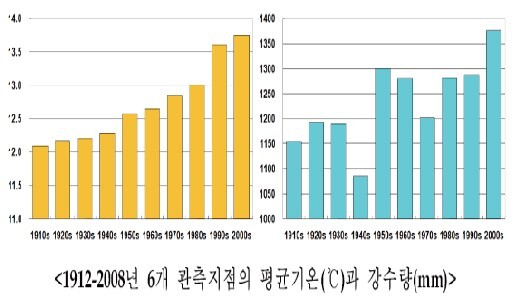hankyoreh
Links to other country sites 다른 나라 사이트 링크
Korean Peninsula is warming at a speed faster than global average

Analysis has emerged indicating the Korean Peninsula is warming at more than twice the speed of the global average. During the last century, the winter season has shortened by more than a month, and the summer season has grown by almost two weeks.
According to a report on climate change on the Korean Peninsula published Thursday by the Korea Meteorological Administration (KMA), the average annual temperature on the Korean Peninsula climbed 1.7 degrees centigrade between 1912 and 2008. This is over twice as much as the global average of 0.74plus/minus 0.03 degrees Centigrade over the same period. Accordingly, the lengths of seasons have changed greatly, too, with winter starting late and spring coming early. The winter season now lasts between 22 to 49 days, while with spring ending early and fall starting late, the summer has grown an estimated 13 to 17 days. With an increase in summer precipitation and localized torrential downpours, the yearly precipitation has also increased approximately 19 percent over the same period.
The KMA explained that in South Korea, urbanization has made fair progress, concentrating large populations within a small area, so the temperature increase is greater than in other regions. It said 20 to 30 percent of the temperature increase over the last century is the result of urbanization.
The KMA predicted that if the concentration of carbon dioxide in the atmosphere continues to increase and hits 720 parts per million by 2100, twice the current level, the average annual temperature on the Korean Peninsula at the end of the 21st century will be four degrees higher than now. The winter season could disappear on the islands of Jeju-do and Ulleung-do as well as along the East Sea and South Sea coasts. In this case, average annual precipitation would increase by 17 percent, but since the temporal and spatial fluctuations of the precipitation will increase, losses from localized torrential downpours and droughts are expected to worsen, too.
Please direct questions or comments to [englishhani@hani.co.kr]
Editorial・opinion
![[Column] Season 2 of special prosecutor probe may be coming to Korea soon [Column] Season 2 of special prosecutor probe may be coming to Korea soon](https://flexible.img.hani.co.kr/flexible/normal/500/300/imgdb/original/2024/0426/3317141030699447.jpg) [Column] Season 2 of special prosecutor probe may be coming to Korea soon
[Column] Season 2 of special prosecutor probe may be coming to Korea soon![[Column] Park Geun-hye déjà vu in Yoon Suk-yeol [Column] Park Geun-hye déjà vu in Yoon Suk-yeol](https://flexible.img.hani.co.kr/flexible/normal/500/300/imgdb/original/2024/0424/651713945113788.jpg) [Column] Park Geun-hye déjà vu in Yoon Suk-yeol
[Column] Park Geun-hye déjà vu in Yoon Suk-yeol- [Editorial] New weight of N. Korea’s nuclear threats makes dialogue all the more urgent
- [Guest essay] The real reason Korea’s new right wants to dub Rhee a founding father
- [Column] ‘Choson’: Is it time we start referring to N. Korea in its own terms?
- [Editorial] Japan’s rewriting of history with Korea has gone too far
- [Column] The president’s questionable capacity for dialogue
- [Column] Are chaebol firms just pizza pies for families to divvy up as they please?
- [Column] Has Korea, too, crossed the Rubicon on China?
- [Correspondent’s column] In Japan’s alliance with US, echoes of its past alliances with UK
Most viewed articles
- 1[Column] Season 2 of special prosecutor probe may be coming to Korea soon
- 2‘We must say no’: Seoul defense chief on Korean, USFK involvement in hypothetical Taiwan crisis
- 3N. Korean delegation’s trip to Iran shows how Pyongyang is leveraging ties with Moscow
- 4Amnesty notes ‘erosion’ of freedom of expression in Korea in annual human rights report
- 5[Editorial] Korea’s surprise Q1 growth requires objective assessment, not blind fanfare
- 6Division commander ordered troops to enter raging flood waters before Marine died, survivor says
- 7[Reportage] On US campuses, student risk arrest as they call for divestment from Israel
- 8Korea sees more deaths than births for 52nd consecutive month in February
- 9Is N. Korea threatening to test nukes in response to possible new US-led sanctions body?
- 10Is Japan about to snatch control of Line messenger from Korea’s Naver?